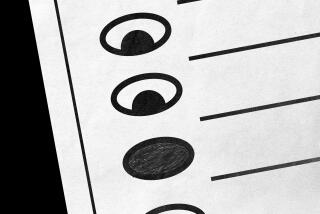Yeas for the Justices
- Share via
Justices of the California Supreme Court and the Court of Appeals are subject to periodic confirmation by a simple majority of voters. They appear unopposed on the ballot; voters are asked only whether the judge should be retained for another term of up to 12 years. We urge a yes vote on the four Supreme Court justices on the Nov. 3 ballot and the 15 Court of Appeals justices who sit in Los Angeles, Orange and Ventura counties.
California’s constitutional retention requirement was never intended to be a referendum on a judge’s personality, the number of times he or she has upheld the death penalty or the politics of the governor who appointed them.
For the record:
12:00 a.m. Oct. 21, 1998 ORANGE COUNTY PERSPECTIVE Clarification
Los Angeles Times Wednesday October 21, 1998 Orange County Edition Metro Part B Page 8 Editorial Writers Desk 3 inches; 78 words Type of Material: Correction
An editorial on Monday listed the Court of Appeals justices in Los Angeles, Orange and Ventura counties who must stand for retention on the Nov. 3 ballot. Six additional justices, whose names were not published, sit in Riverside, San Bernardino and San Diego counties. However, they in fact also appear on the ballot in Orange County.
They are Presiding Justices Daniel J. Kremer and Manuel A. Ramirez and Associate Justices Alex C. McDonald, James A. Mcintyre, Barton C. Gaut and James D. Ward. The Times endorses the retention of these individuals as well.
The requirement was designed instead as a way to remove a judge who had committed a crime or who simply couldn’t function on the appellate bench, someone who couldn’t or wouldn’t do the job.
California has long prized the independence of its judiciary--and for good reason. Our courts, like federal courts, are supposed to stand above politics so judges can, when necessary, check the power of elected officials. Judicial offices here are nonpartisan and judicial codes of conduct strictly limit the sort of campaigning that judicial candidates can do. In states with a more partisan tradition, judicial campaigns and even judges’ decisions often reflect political fashions and the whims of elected officeholders rather than a careful reading of the law.
California’s independent judiciary depends on responsible voters. In recent years, however, a growing number of voters have simply not voted at all in these retention elections or have voted no. Whether those who marked no misunderstood the retention requirement, concluded some particular justice was no longer qualified to serve or just felt in a contrary mood, the result has been the same: several distinguished and highly qualified judges have nearly lost their seats at the polls. Continued voter apathy or blanket negativism will leave other jurists vulnerable to attacks by single-issue extremists angry with a particular ruling.
Four Supreme Court justices and 15 local Court of Appeals justices appear on the November ballot. Each has more than met the criteria for retention. The men and women listed below are well qualified and have served California with distinction. They deserve a yes vote.
California Supreme Court Justices:
Chief Justice Ronald M. George
Associate Justice Janice Rogers Brown
Associate Justice Ming William Chin
Associate Justice Stanley Mosk
Court of Appeals Justices:
Presiding Justice Vaino Spencer
Associate Justice Morio L. Fukuto
Associate Justice John Zebrowski
Associate Justice H. Walter Croskey
Presiding Justice Charles S. Vogel
Associate Justice Daniel A. Curry
Associate Justice Orville “Jack” Armstrong
Associate Justice Paul H. Coffee
Associate Justice Arthur Gilbert
Associate Justice Earl Johnson, Jr.
Associate Justice Richard C. Neal
Associate Justice David G. Sills
Associate Justice William W. Bedsworth
Associate Justice W.F.”Bill” Rylaarsdam
Associate Justice Edward J. Wallin
More to Read
Get the L.A. Times Politics newsletter
Deeply reported insights into legislation, politics and policy from Sacramento, Washington and beyond. In your inbox twice per week.
You may occasionally receive promotional content from the Los Angeles Times.










